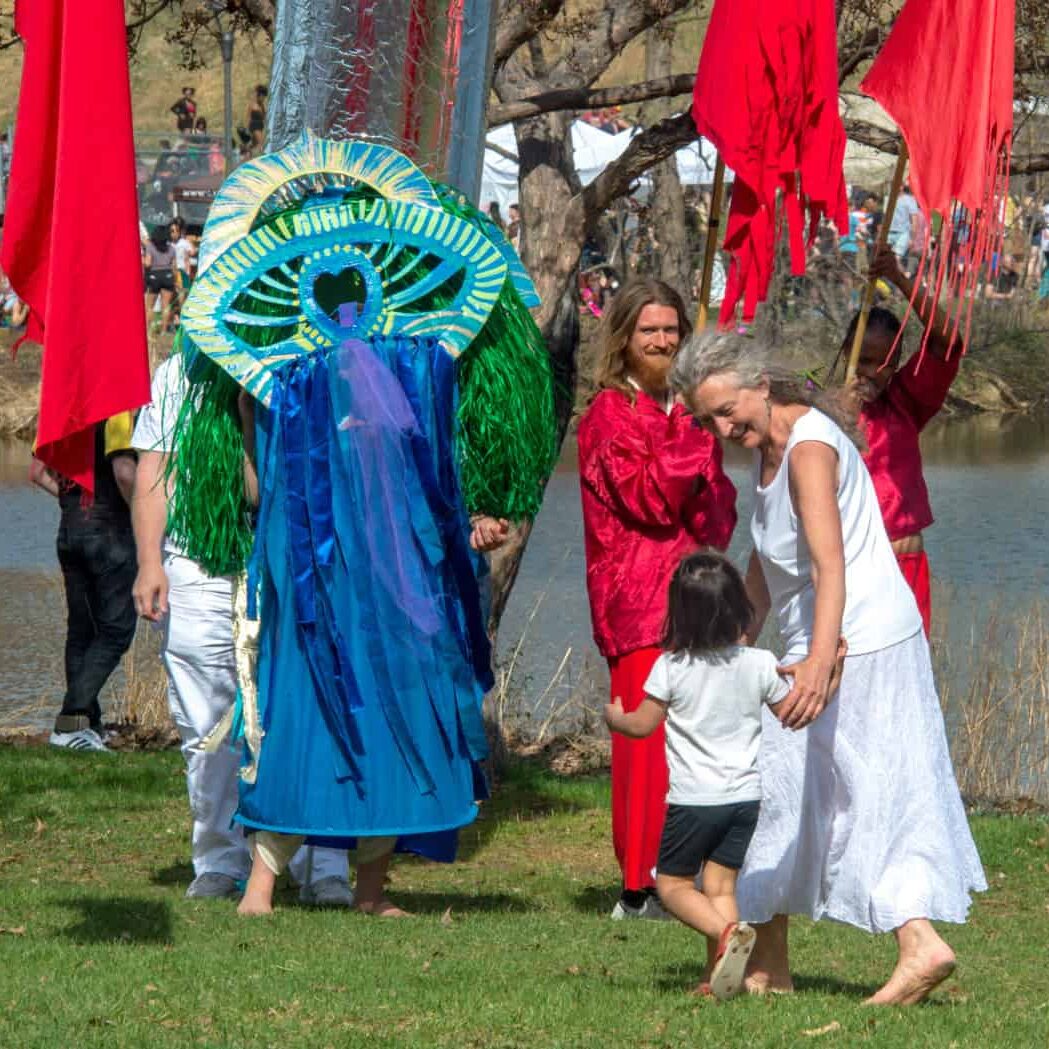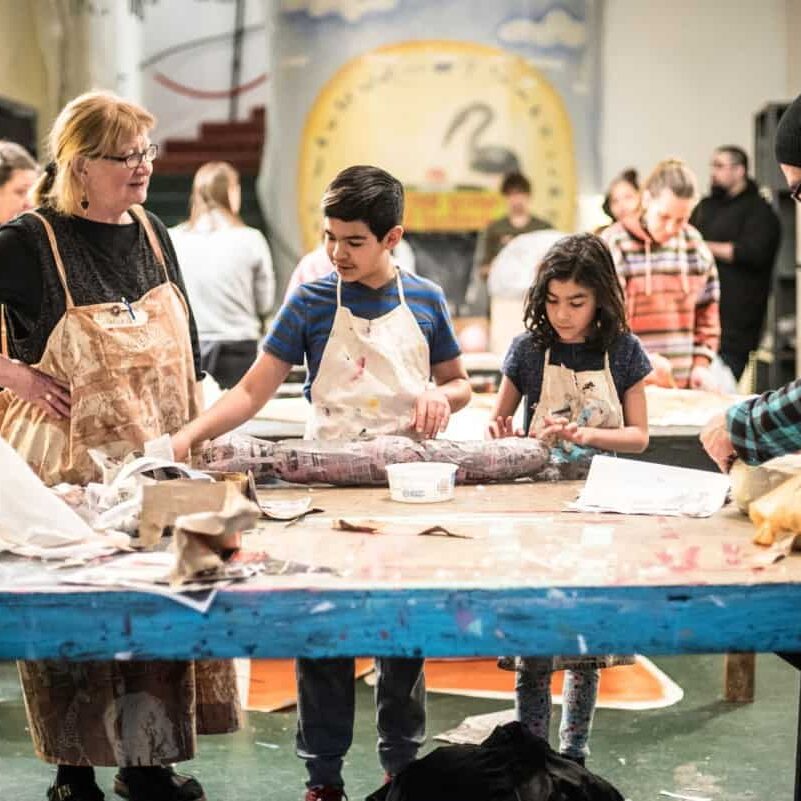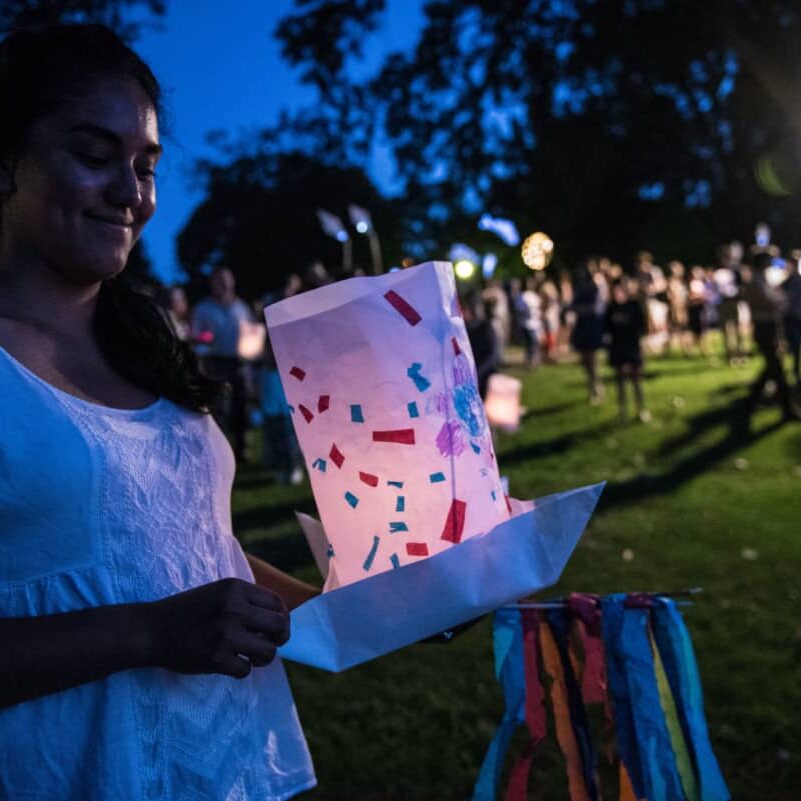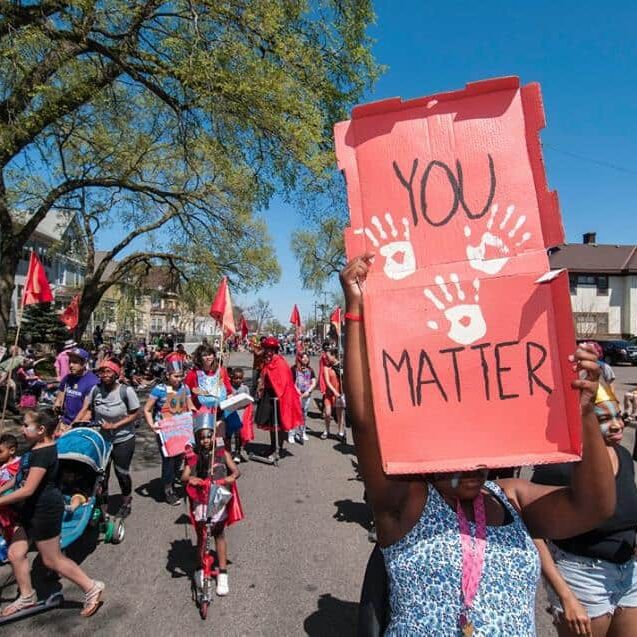Challenges of Our Field
This document is intended as background information to add context to the January 2019 announcement from In the Heart of the Beast Puppet and Mask Theatre that the organization will reduce its operations in the coming months. That announcement and other supplementary materials can be found at hobt.org/imagine.
HOBT sees no single factor leading to the organization’s current position. HOBT is experiencing a wide range of challenges that are faced by other nonprofits, especially mid-sized arts organizations. Below is an exploration of the key issues as we understand them.
Ticket Sales Don’t Come Close to Covering the Cost of Producing Live Performance
Theater patrons should know that, for nonprofit arts organizations, ticket sales generally do not come anywhere close to covering stage production costs. Even paying full price for good seats at the biggest theaters in town does not cover the full cost of what it takes to make that production happen. At HOBT, for example, when we produce LA NATIVIDAD, we can charge our highest ticket prices of the year and sell every ticket to every performance. That will bring in about $30,000 in ticket revenue. But the production budget for La Natividad is closer to $60,000. If you have ever attended a performance of La Natividad, you know that it is not an extravagant production. Most of the 100 performers are volunteers, and the stipends given to paid performers would fall below minimum wage if calculated on an hourly basis. HOBT stretches every dollar to a near-breaking point. And still a further subsidy is required to make a production like La Natividad possible.
Most of the live performances we see, then, are made possible only when ticket sales can be supplemented with funding from individual donations, grants from foundations and governments, and earned income from things like advertising, beer and wine sales, and merchandise. The ratio of this funding mix varies from one theater company to the next, and from one type of show to the next. In recent memory, HOBT’s income has been relatively equally balanced between three sources: Individual donors, foundation and government grants, and earned income (including ticket sales). HOBT finds it more and more challenging in recent years to stretch these income sources to cover the costs of our work.
People and Things Cost More Over Time
Even just continuing the same work becomes more expensive each year. Old buildings need upgrades to maintain physical accessibility. Additional investments are needed to make programming safe and accessible across age, language, culture, and other obstacles to accessibility. Audiences generally expect a wide range of digital and analog options for learning about shows, purchasing tickets, and providing feedback. These are all good things. And they require resources.
Costs for people increase over time as well. Which is not to say that most folks working the the Theater field are well paid. This is another area where HOBT stretches its dollars sometimes too far. The median hourly pay for HOBT’s 15 permanent employees is under $18 per hour, and the ratio of the highest paid employee to the lowest is less than 2 to 1. While HOBT has a fairly generous Paid Time Off policy, employees receive no other benefits. Employees are on their own to find health insurance coverage, dental coverage, retirement savings plans or long term disability insurance. Over time, this level of compensation affects who shows up on our permanent staff. The people who are able to stick around are either willing and able to live on limited income (most permanent staff qualify for health care subsidies, and some qualify for MinnesotaCare), enjoy the privilege of a safety net in other family members whose resources can cover living expenses, or live on extreme thrifting.
Foundation Grants are Becoming Fewer and More Challenging to Secure
Income from Foundations can generally be classified as General Operating grants and Program grants. General Operating grants can generally be used however an organization sees fit, as long as the money is being responsibly used toward the organization’s mission. Program grants are designated for a specific project or purpose, and generally must be spent within a specific time period.
For midsized arts organizations like HOBT, General Operating grants are becoming harder to come by. The Bush Foundation and the General Mills Foundation ended their arts programs after having been bedrock arts funders in Minnesota for many years. The Target Foundation reduced the size of its awards to arts organizations in 2018, raising questions as to whether further reductions are to come. The McKnight Foundation arts program serves more arts organizations than ever, but with a similar total budget each year, reducing the program’s ability to support capital projects or other emergent needs. Among HOBT’s smaller general operating grant funders, only the HJ Andersen Foundation increased funding in 2018. Another long-time general operating supporter cut funding by twenty percent.
Which is not to say that any of these Foundations are not doing good work. Each faces their own challenges in supporting work across multiple programs addressing a wide range of competing needs in an increasingly unsteady world. In one sense, these funders face the similar challenge of being asked to do more every year with the same set of resources.
With fewer and less predictable sources of general operating funds available, arts organizations are increasingly dependent on program grants. These are grants that cover a specific project or program, usually over a single one-year period. The nature of program grant funding is also shifting. The Jerome Foundation funds programs that support early career artists. At HOBT, for the past eight years, Jerome funded the Puppet Lab program. And in acknowledgement of some of the realities for arts funding already described here, Jerome funds organizations for two years at a time and recently updated its policies to allow for gradually increasing program costs. Even so, support from the Jerome Foundation covers about half all Puppet Lab expenses. A bit more of the program is funded by ticket sales, and that leaves a significant gap for HOBT to fill with increasingly scarce general operating funds. In the world of puppetry, the Jim Henson Foundation is an important source of funding for the creation of new work. That foundation recently increased the size of individual project development grants in recognition of the fact that producing new work becomes more expensive over time. With both Jerome and Henson Foundations, these larger grants are made with the same total funding granted each year, which means fewer grants are available, and so the grant program is more competitive.
Some funders are shifting priorities. The Seward Co-op’s SEED program invites customers to round up their purchase to the nearest dollar and directs these funds each month to a nonprofit selected by co-op staff. HOBT was selected two years in a row for the SEED program to support MayDay. HOBT supporters broke SEED program participation records both times, bringing in more than $25,000 in one year, and more than $28,000 the next. But this year, during the selection process, co-op staff made a decision to fund only direct service organizations. Again, we have only love and respect for this program. The SEED program is a tremendous community asset and will support 12 highly deserving organizations this year. We all are lucky to have it in our community.
Given the changing landscape, some funders and foundations are reducing or closing their operations. The Minneapolis Foundation announced that its Summer 612 program (funding youth internships) will be placed on hold for 2019. VSA Minnesota is an organization that (among other things) provides funding to arts organizations to improve accessibility. VSA recently announced that they will end their work in 2019.
Minnesota State Arts Board Funding
Over the same decade that general operating funds have declined, the Minnesota Arts and Cultural Heritage Fund, through the ”Legacy Amendment”, effectively tripled the budgets of the Minnesota State Arts Board (MSAB) and Regional Arts Councils across the state. As a result, not only does Minnesota enjoy the highest per capita rate of public arts funding in the United States, no other state even comes close. Minnesotans are truly blessed to have this resource available.
The MSAB Operating Support program provides general operating funds to arts organizations with budgets over $500,000. About 5% of HOBT's budget comes from MSAB Operating Support. The level of support each year is dependant on multiple factors including organizational size, economic activity in the state, and the number of organizations requesting support. For HOBT in recent years, MSAB operating support varied from $42,000 to $60,000. That support is a critical part of HOBT’s budget.
In addition to General Operating support, the State Arts Board offers multiple project funding programs funded in part by Legacy Amendment dollars as described above. These programs cover 90 percent of the direct cost of a project plus an overhead allowance, which comes close to full funding. During HOBT'S 2018 fiscal year, MSAB project funding made possible a touring production of THE STORY OF CROW BOY ($32,000), an elementary school residency on Indigenous Resistance ($16,000), and HOBT's Phillips Project, which provides year-round after-school and summer programming for 150 underserved youth at three community centers near HOBT ($99,000).
With $42,000 in Operating Support funds, that comes to nearly $200,000 in arts board funding for fiscal year 2018 projects, or almost 20% of HOBT's budget. For the following fiscal year, HOBT's Operating Support funds went up (to $60,000), but we did not have a touring project to propose, and proposals were denied for future projects with either the Indigenous Resistance residency or the Phillips Project. And so HOBT’s Arts Board funding was $130,000 lower from one fiscal year to the next.
MSAB Project grants are designed to give equal footing to as many organizations as possible each year. Project grants do not support ongoing programs, and projects must be planned for completion - from set-up to evaluation - within a 12-month period. A great deal of advance planning is required before learning whether a project has been funded. An organization must be careful not to rely on receiving these project grant funds in any given year.
Changing Donor Trends
About one-third of HOBT's budget comes from individual contributions. HOBT has a relatively large number of contributors compared to other similarly sized organizations. HOBT fundraising appeal mailings go out to about 6,000 households, which includes recent donors and ticket buyers. At the same time, HOBT's average individual gift size is smaller than for peer organizations. A larger pool of smaller donors makes sense for HOBT. It is a point of pride for HOBT to have so many donors from the core neighborhoods surrounding the theater.
HOBT lacks a significant number of large (above $10,000), predictable individual donations that provide stability to larger arts institutions. HOBT’s board members are not selected based on their ability to give, but their ability and willingness to contribute their expertise to the organization. HOBT board members generally contribute to fundraising efforts by collecting bucket donations on MayDay, hosting house parties, and planning events.
Like grant funding, individual funding has become less predictable for HOBT. After the 2016 elections, HOBT saw a surge in individual giving for MayDay 2017. And after changes to the tax code were announced late in 2017, giving to HOBT's Winter Appeal hit record levels. But then 2018 giving dropped precipitously. Perhaps this was because donors who usually give in the springtime gave early for the tax advantage. Or perhaps local and national headlines leave people increasingly unsure of the future. Or maybe other worthwhile causes compete for attention.
Performance Space is Expensive Whether an Organization Owns It or Rents It
HOBT owns the Avalon Theater at 1500 East Lake Street. HOBT has made a home in the Avalon for nearly 30 years. When HOBT moved in, the Avalon had been abandoned for years and had holes in the roof large enough to let sunlight in. Two renovations of the building made the Avalon what you see today. The building is only marginally accessible for individuals with mobility challenges. Air quality keeps away patrons who have sensitive respiratory systems. Some of the plumbing and electrical systems are nearly 100 years old. The building has no sprinkler system. The home-made lighting grid is sometimes difficult to access safely. Office space is overcrowded, and heating and cooling are uneven.
For most of those three decades, HOBT has questioned whether to invest in the Avalon to make it safer, more accessible and more useful, or to let the Avalon go to another owner who may be better able to care for it. You might have been part of the community discussions that led to a 2016 decision by the HOBT board to stay in the building and work to raise the funds needed for a renovation. The board determined that, without a renovated Avalon, HOBT would not likely be able to continue to serve the communities that have supported our work for 45 years.
HOBT also determined that renting a considerably smaller space would not reduce expenses when compared to owning our current space. HOBT annual expenses related to owning the 8,000 square foot Avalon Theater come to about $100,000 per year. That includes mortgage payments, insurance, utilities, and maintenance tasks like clearing snow and maintaining heating and cooling equipment. In a 2018 commercial real estate market, the cost of renting 2,000 - 3,000 square feet of office, storage and studio space would range in price from $80,000 to $120,000 per year.
HGA Architects conducted a two-day pro bono design session with HOBT in 2017. The preliminary design developed included improving accessibility, adding gender neutral restrooms, leveling the raked floor of the auditorium, reducing the size of the auditorium and adding dedicated work space, classroom space, meeting space, and a larger lobby. Plan options would include an elevator and increased square footage on the second floor of the building. This fully-loaded plan was estimated to cost $5 Million
Recent information suggests that HOBT will not be able to raise even half that much. Over the summer of 2018, HOBT hired a consultant to conduct a feasibility study for a capital campaign. The goal of this study was to estimate, based on our current donor base, how much cash HOBT could reasonably expect to raise for a building renovation. After three months of work, our consultants suggested that HOBT would be able to raise approximately $1.5 Million, far short of what it would take to implement our $5 Million vision. In a 2015 building condition assessment, HOBT estimated that $1 Million was needed just to cover deferred maintenance on the building’s roof, facade and other building systems.
Leadership Transitions Are Difficult
Sandy Spieler started as HOBT’s Artistic Director 45 years ago. Three years ago, Sandy transitioned from her role as sole Artistic Director to a role as part of an Artistic leadership Team that also includes program directors Bart Buch, Alison Heimstead, and Steve Ackerman. Though Sandy has not held a title as HOBT’s Artistic Director for three years, she continues to lead MayDay and continues to be perhaps the most public face of the organization. Long before HOBT realized the gravity of its financial outlook, Sandy had already decided that 2019 would be the last year she would lead the MayDay process. Sandy is intentionally creating space for new leadership to emerge. You can read Sandy’s full letter about this decision here.
HOBT’s work toward Diversity, Equity, and Inclusion
Like many other institutions, HOBT has much work to do in identifying and dismantling roots of White Supremacy Culture in our work. HOBT has long been aware that, while our audiences and our artist pool represent a diverse cross-section of the communities present in HOBT’s core neighborhoods, at the decision-making level our staff and board are almost entirely White European-Americans. HOBT understands that nearly all-white leadership is unacceptable in an organization with a mission to bring people together for the common good and based in neighborhoods where people of color make up a majority of the population.
MayDay artists of color tell us that these dynamics are not unique to HOBT. These are the ways that White Supremacy Culture creates obstacles for people of color in other workplaces as well as in housing, education, and the justice system. HOBT did not invent White Supremacy, but we have been fostering it in our work in a way that is antithetical to HOBT’s values.
HOBT has invested significant time and resources over the past 18 months, since summer 2017, to better understand ourselves as an organization, and to identify what changes will be necessary to more authentically represent the communities present in HOBT’s core neighborhoods. HOBT’s artists of color have been essential to this work. We are humbled by their gracious contributions to helping HOBT understand where our practices must change, and helping us to imagine how to better live into our values.
In the summer of 2017, the HOBT board engaged in a training session to begin the process of understanding our own culture as individuals and as an organization as a way to better understand our relationship with other cultures. All board, staff, and MayDay artists were provided copies of adrienne maree brown’s EMERGENT STRATEGY, and participated in group discussions aimed at building common vocabulary around the change work we want to do together. In the fall of 2017, HOBT staff began attending twice-monthly meetings dedicated to exploring various aspects of HOBT’s Culture and goals for change.
In early 2018, HOBT’s Executive Director began conversations with MayDay artists of color about changes needed to the MayDay process to address cultural appropriation, microaggressions, and a sense of urgency that blocks out new ideas. In the spring of 2018, HOBT’s board approved a strategic framework that calls for the development of an organization-wide Diversity, Equity, and Inclusion (DEI) Plan. Over the summer of 2018, all board and staff completed an Intercultural Development Inventory (IDI) assessment and attended a one-on-one session with a certified IDI assessor to review assessment results and individual development goals.
Also over the summer, HOBT engaged consultants including Nadja Rubenova, Sandra Richardson, Susan Raffo, and Marie Michael to facilitate further discussions with MayDay artists about changes needed within the MayDay process. These consultants provided a more objective view of HOBT’s culture and balanced patience with the challenges of the work with firm insistence that we can do better. This work led to the development of a set of written agreements that will be used as part of the 2019 MayDay process and will be used to evaluate HOBT’s progress.
And we know this is not enough. Culture change takes time and commitment. We certainly do not claim to have fully addressed these issues, but staff, board, and artists have a shared understanding that only by fully embracing this work can we carry the organization forward. And now, just as this 18 months of work is starting to show up in changes to HOBT policies and practices, the organization will reduce staff and programming. On its face, this will make the work more challenging. In the short term, a smaller staff is not likely to be more diverse. HOBT is making changes to the MayDay process just as it begins a conversation about turning that process over to others.
At the same time, this 18-months of work has prepared HOBT to ensure that considerations of diversity, equity and inclusion are present in every level of discussion and planning for what happens next with MayDay, with the Avalon Theater, and with the other valuable work HOBT has built with our neighbors.
MayDay as an Example
While these challenges affect all of HOBT’s programs, MayDay provides the biggest example of how these factors come together to present an insurmountable challenge. Most of our neighbors do not realize that HOBT is the sole entity responsible for financing and producing MayDay. MayDay expenses exceed MayDay revenue every year and HOBT can no longer cover this annual shortfall. Generally, foundations are not interested in project grants that maintain the same project each year. Individual donations are the biggest part of financing MayDay, but they vary greatly depending on things like the weather on the day of the event. HOBT has been unable to reduce the costs of MayDay without dramatic cuts to artistic content. MayDay Culture fosters a sense of urgency in MayDay that asks too few people to do too much work over too short a period of time. The feverish pace of the work does not make time to address microaggressions, opaque decision making, and cultural appropriation that can come up in any workplace. For all of these reasons, HOBT can no longer solely produce MayDay.
Our Challenges are Not Unique
While every organization is unique and faces its own complicated set of challenges, the issues facing HOBT described here also present challenges to other arts organizations. Large-scale arts and culture events are decreasingly stable enough to support themselves. Art Shanty Projects announced this year that, after record attendance for their 2018 event, a State Arts Board project grant did not come through and so they will be unable to host the event in 2019. Similarly, the Northeast Minneapolis Arts Association did not receive a hoped-for State Arts Board grant to support Art-A-Whirl, putting the future of that event and the entire organization in jeopardy. Close to home for HOBT, the 120-year tradition of fireworks in Powderhorn Park ended five years ago.
Over the past two years, the Twin Cities have suffered the loss of multiple key pieces of our arts infrastructure. The Soap Factory ceased operations months ago and just recently announced the need to sell their building in order to repay debts. The Red Eye Collaborative recently lost its space of nearly 30 years. Intermedia Arts closed its doors earlier this year after 44 years. Patrick's Cabaret celebrated it's “Sunset Season” last year after losing its home of 17 years. We still feel the loss of Bedlam Lowertown and Bedlam Studio as Bedlam Theatre shut down two years ago after 25 years of work. These are HOBT’s peers. HOBT’s artistic community overlaps with the artistic communities of every one of these organizations.
Where We Are Today
These are the factors that bring HOBT to a position in which the path we are on leads to an end in six months. While HOBT has time to navigate a new path, we must remind ourselves that we are doing so in the context of increasing expenses, costly space needs, important Diversity, Equity, and Inclusion work, dwindling grant funding resources, changing donor trends, and staff that is already giving a tremendous amount of themselves at what is often disappointingly low pay.
HOBT is not out of cash today. Bills and payroll checks are being delivered on time. We see no reason today why HOBT should not be able to make good on every contract agreement we have made. But without major changes in both our programming and in our network of support, we will have no choice but to close our doors and sunset our organization.






